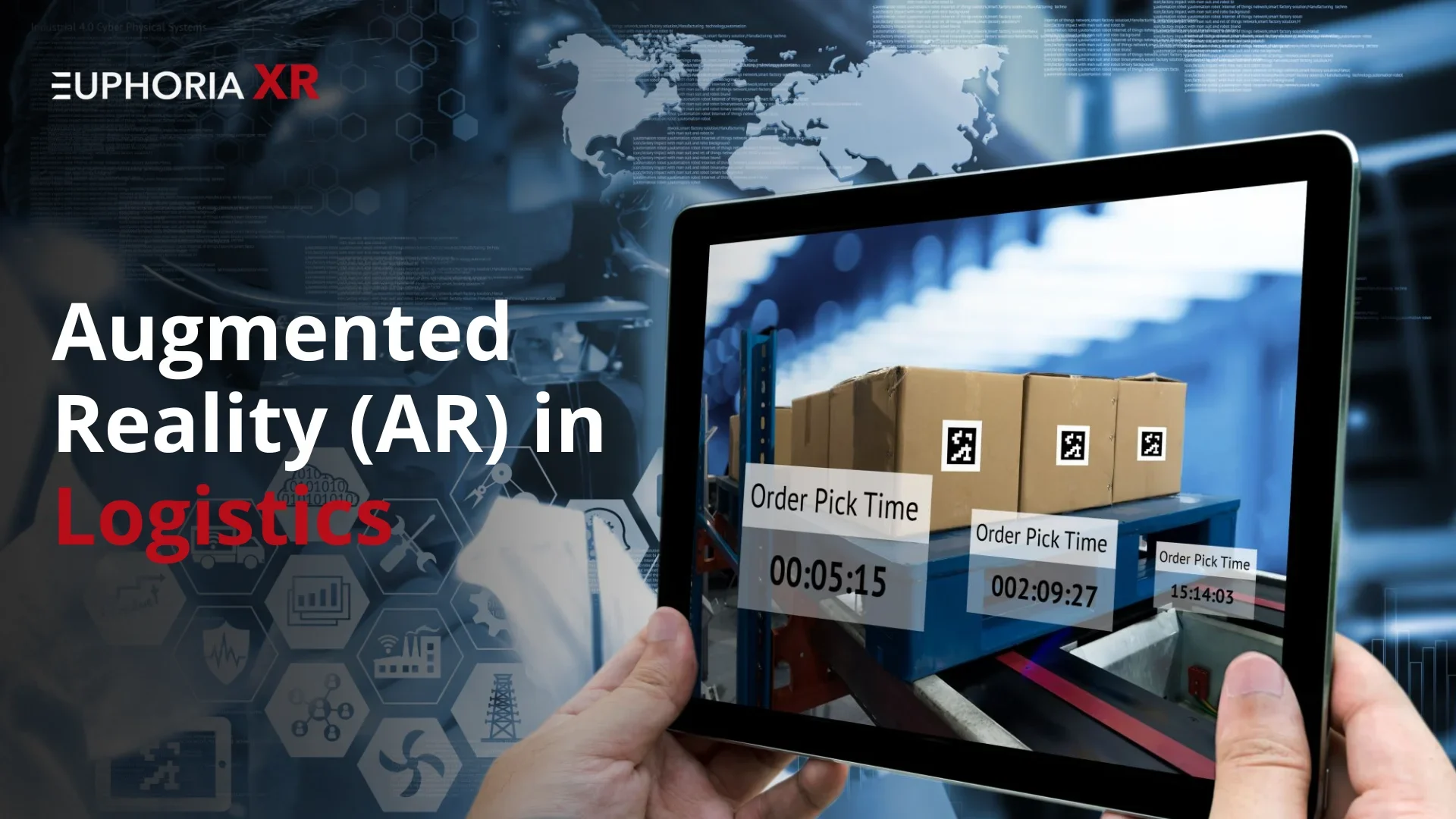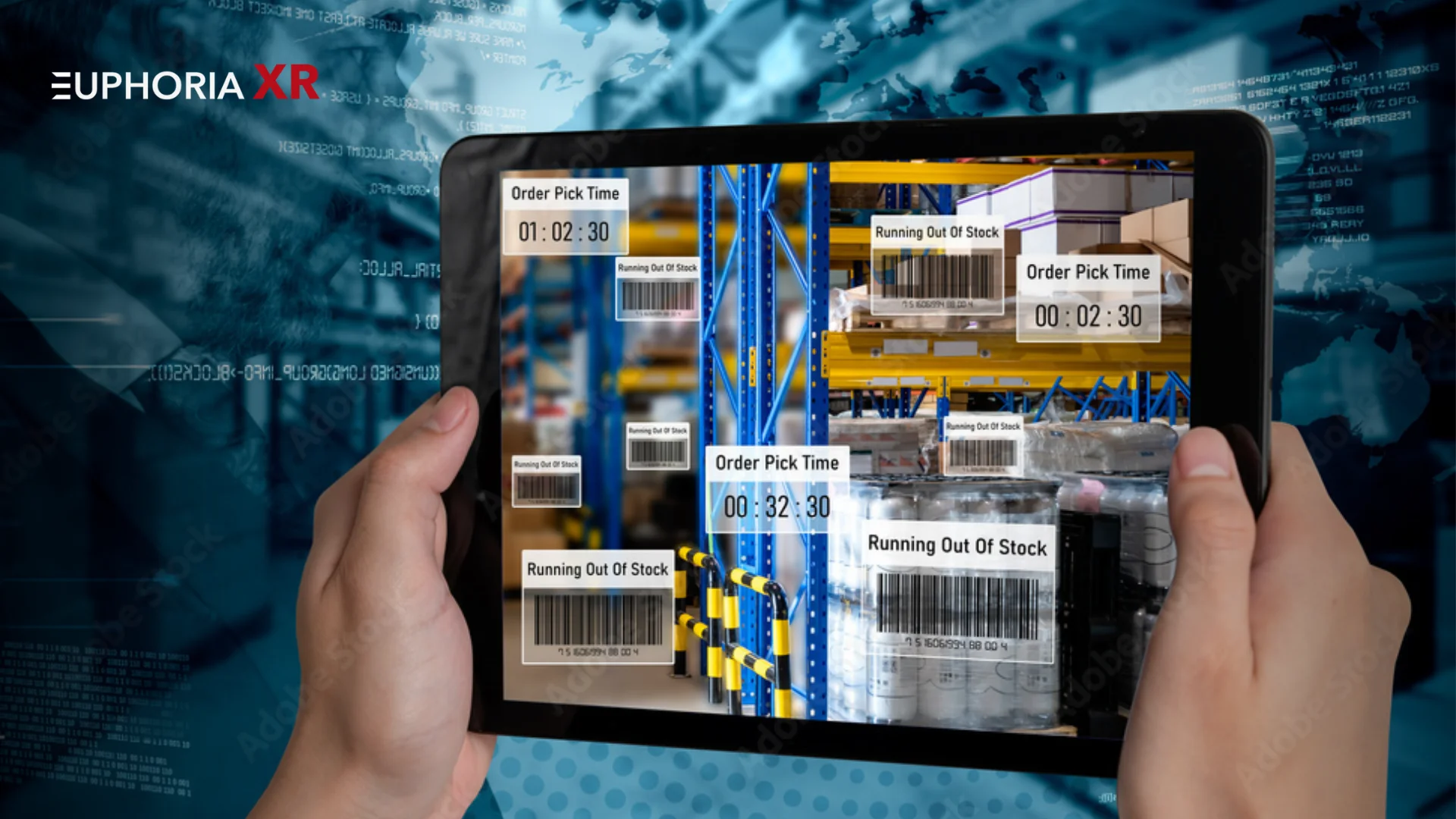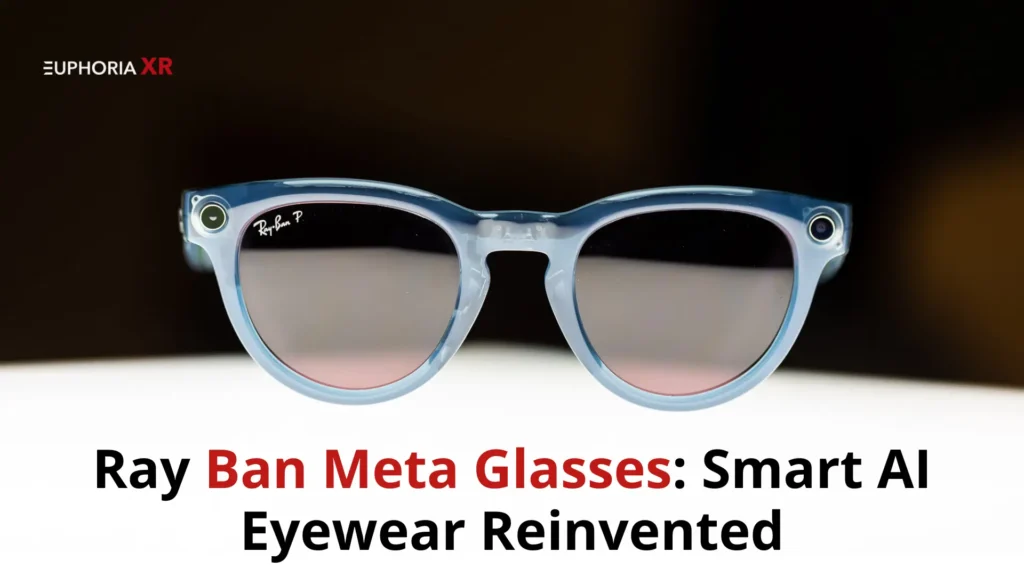“Augmented Reality in Logistics: An Unmissable Game-Changer”
Imagine entering a warehouse where delivery drivers see optimum routes on their windshields, shipments are tracked in real-time without requiring manual barcode scanning, and staff members can choose things without consulting paper lists. This is augmented reality (AR) in logistics, not some far-off future.
Augmented Reality (AR) enables supply chain businesses to boost their workforce productivity, accuracy, and efficiency while managing increasingly complicated worldwide supply chains. PwC research predicts that the world economy will benefit from augmented reality by $1.5 trillion by 2030, primarily through the transportation and logistics sectors. DHL, XPO Logistics, BMW, and Samsung SDS lead the list of companies which already put augmented reality (AR) technology to work within their logistics operations. These organizations demonstrate improvements in three areas: delivery order precision as well as warehouse operational output, and staff education programs.
Introduction to Augmented Reality in Logistics
Through its ability to bridge the gap between digital and physical processes, augmented reality (AR) is rebuilding logistics. With AR-powered smart glasses helping employees with picking duties, real-time inventory tracking doing away with manual barcode scanning, and AR-assisted navigation streamlining delivery routes, warehouses are getting smarter.
The implementation of augmented reality (AR) in supply chain management helps organizations enhance their workflow operation, precision, and efficiency when operating complex supply chain systems. People clearly understand how augmented reality impacts logistics operations, but how specifically does it work, along with its benefits? Let us examine its elements and practical uses.
Components of Augmented Reality in Logistics
The four main pillars of AR technology in logistics are data analytics, sensors and cameras, software applications, and AR devices.
Component #1: AR Devices
Logistics teams utilize AR-enabled mobile devices together with heads-up displays (HUDs) and AR Smart Glasses for improving warehouse and transportation operations. The adoption of AR smart glasses as a vision picking solution allowed DHL to improve warehouse efficiency through fewer mistakes and achieve 25% higher productivity rates.
Component #2: AR Software applications
WMS systems today include AR-based applications that provide digital warehouse mapping and navigation support along with vision picking capabilities. During 2021, XPO Logistics achieved a 20% improvement in production efficiency rates following the deployment of augmented reality technology across multiple distribution centers.
Component #3: Sensors and Cameras
AR uses hardware sensors and digital overlays to improve inventory visibility and quality control, from RFID-enabled package monitoring to AI-powered computer vision.
Component #4: Data Analytics and AI
The combination of augmented reality with predictive analytics enables logistics businesses to better anticipate customer needs while raising their route efficiency and making quicker operational choices. When tested in pilot projects, augmented reality applications driven by artificial intelligence reduced supply chain interruptions by 30%, according to McKinsey research.
How Can Businesses Use Augmented Reality to Strengthen Logistics?
One of the key problems in logistics is still inventory management. The Harvard Business Review estimates that inventory distortion—either overstocking or understocking—costs multinational corporations $1.1 trillion a year. By providing real-time inventory visualization via smart glasses and portable AR devices, AR is resolving this problem.
AR-powered inventory tracking is being used by retailers like as Walmart and Amazon to minimize supply inconsistencies. AR-led inventory management can increase stock accuracy by up to 95%, which can result in 30% faster order fulfillment, according to a study by the Capgemini Research Institute.
Augmented Reality for Maintenance
Downtime of transportation and storage equipment can cost millions of dollars in lost profits. Technicians can use AR to get real-time repair guidance and do hands-free diagnostics. PTC’s research indicates that businesses that use AR for maintenance save 20% on maintenance expenses and 25% on equipment downtime.
Augmented Reality for Transportation and Delivery
AR has a significant impact on fleet management and last-mile delivery optimization. AR-enabled windshield displays to cut down on delivery times and fuel expenses while assisting drivers in navigating challenging delivery routes.
FedEx has made investments in delivery solutions driven by augmented reality that work with its AI-powered route optimization systems. As a result, last-mile delivery failures have decreased by 15%, and on-time deliveries have increased by 10%.
Augmented Reality for Training
High personnel turnover rates plague the logistics sector, and in certain areas, warehouse labor shortages can exceed 40% (Deloitte, 2022). AR-based training initiatives are boosting knowledge retention and hands-on experience while drastically cutting onboarding time by 50%.
According to PwC research, employees who received AR training outperformed those who received traditional training by 40% and retained 30% more information. The logistics industry depends on DHL and BMW to teach their new employees order-picking methods by utilizing augmented reality simulations.
Augmented Reality for Warehouse Optimization
The utilization effectiveness of warehousing facilities undergoes substantial transformation because of AR technology. Warehouse space utilization stands at 50 percent globally because CBRE reports ineffective layouts and poor planning.
Companies achieve maximum space utilization through the implementation of digital twin systems developed by augmented reality that represent warehouse facilities virtually.
Benefits of Implementing Augmented Reality in Logistics
The supply chain management sector sees a transformation under the implementation of augmented reality by businesses that aim to boost productivity and cut operational costs.
#1: AR Enhances Warehouse Efficiency and Accuracy
AR-assisted warehouse picking increases accuracy rates to over 99%, lowering errors and improving order fulfillment, according to a 2023 Accenture research.
#2: AR Streamlines Warehouse Workflows and Reduces Errors
Using smart glasses for vision picking increases worker productivity and decreases mispicks while lowering picking errors by 40%.
#3: AR Strengthens Warehouse Employees and Enhances Training
According to PwC workforce research, individuals who receive AR training perform 35% faster and commit fewer errors than those who receive traditional training.
#4: AR Addresses High Employee Turnover
According to the Deloitte Logistics Report, AR-based training helps businesses retain talented employees and minimize turnover rates by reducing onboarding time by 50% and increasing job satisfaction by 25%.
#5: AR Enhances Worker Safety
Real-time hazard alerts from AR overlays reduce workplace injuries by 25% and guarantee adherence to safety rules.
#6: AR Improves Scalability, Flexibility, and Integration
According to a study by the Capgemini Research Institute, AR-driven logistics solutions increase scalability by 30%, enabling companies to integrate AR with their current WMS and ERP systems and manage seasonal demand spikes without requiring significant infrastructure modifications.
#7: AR Saves Cost and Provides Competitive Advantage
According to a Gartner analysis, AR in logistics can save operating expenses by 30% over five years, increasing supply chain agility and lowering inefficiencies to make organizations more competitive.
Imagine a logistics system that maximizes efficiency, minimizes errors, and has smooth workflows. Does that sound good? Let us put it into reality!
Examples and Achievements of Augmented Reality in the Logistics Sector
Supply chain management demonstrates in current applications that AR technology succeeds in enhancing productivity while reducing errors alongside warehouse operation optimization. Four major firms, including DHL, XPO Logistics, BMW, and Samsung SDS, experienced augmentation through AR technology, leading to improved operational efficiency and decreased expenses.
1. DHL improves Picking Efficiency by 25% with Augmented Reality
One of the first companies to incorporate AR smart glasses into its vision selection procedure was DHL. DHL implemented smart glasses with augmented reality overlays to give employees hands-free, real-time picking instructions during a test operation spanning several warehouses.
The outcomes were striking:
Efficiency in order selection rose by 25%.
Picking and sorting error rates sharply declined.
Because they were no longer required to manually check select lists, employees expressed greater job satisfaction and less stress.
Since then, DHL has extended AR-powered vision picking to several warehouses across the globe, establishing AR as a crucial factor in warehouse automation and productivity.
2. XPO transforms warehouse efficiency with AR and VR
One of the biggest suppliers of supply chain solutions, XPO Logistics, streamlined operations by implementing VR training programs and AR-powered warehouse optimization.
Among the main results of their AR implementation are:
The integration of AR navigation tools resulted in a 20% increase in warehouse efficiency.
Stock inconsistencies were decreased by 30% using AR-based real-time inventory tracking.
Employee onboarding time is halved with VR training programs, increasing training effectiveness and engagement.
XPO has been able to increase operational agility and scale effectively across its logistics hubs thanks to its AR-driven warehouse management solution.
3. BMW Utilizes AR to Enhance Its Warehouse Operations
BMW has improved operational efficiency and decreased warehouse inspection times by incorporating AR-based inventory management and quality control into its logistics workflow.
Among the principal advantages that BMW has attained are:
AR-powered real-time scanning and flaw detection resulted in a 30% reduction in inspection times.
Supply chain interruptions were reduced because BMW was able to anticipate and address logistical bottlenecks before they materialized, thanks to AR-enabled digital twins.
AR headsets are used by warehouse employees to guide order completion, reducing errors and expediting packaging and shipment.
BMW has raised the bar for digital transformation in vehicle logistics by integrating augmented reality.
4. Samsung SDS integrated Vision Picking into their Intelligent Storage Program
AR-based vision picking has been effectively incorporated into Samsung SDS’s intelligent storage and fulfillment centers. SDS is Samsung’s logistics and IT services branch.
Their AR-powered logistics transformation has produced the following outcomes:
Quicker order fulfillment because employees wearing AR smart glasses could find and select things 20% more quickly.
Increased stock accuracy was ensured by a 35% decrease in inventory management error rates.
smooth interaction with their automated warehouse storage systems, enabling real-time tracking of shipments and products with AR assistance.
Samsung SDS keeps improving AI-powered augmented reality solutions for logistics, increasing the intelligence and responsiveness of their warehouses and distribution hubs to market demands.
Suggested Read: https://euphoriaxr.com/top-augmented-reality-brand-experiences/
Expanding the Use of AR Technology in Logistics
Augmented Reality in Logistics and Industry 4.0
Through the fusion of AI, IoT, automation, and AR technologies, Industry 4.0 creates transformative changes to logistics operations, which produce more intelligent supply chain systems. Through AR, industrial facilities enable human-robotic joint operations in automation centers and enhance warehouse space design and instant inventory system tracking. Organizations adopting AR-driven solutions achieve higher productivity rates alongside reduced mistakes, together with major cost reductions, which proves AR essential for modern logistics systems.
Potential for Widespread Adoption
Industry adoption of AR is speeding up, with the worldwide logistics sector predicted to reach $8.9 billion by 2030. Companies are using AR to boost employee productivity, lower operating expenses, and satisfy growing e-commerce needs. Businesses implementing AR-based inventory tracking systems achieve rapid delivery and reduced errors, along with expectations that AR-powered logistics will decrease operational expenses by 30% throughout five years, according to Gartner. Businesses recognize the benefits of AR, thus it transitions from inventive technology to indispensable logistical technology in the market.
How to Navigate the Integration of Augmented Reality in Logistics
Step 1: Determine Important Domains for AR Integration
The first step requires identifying essential areas where AR integration brings benefits to the business. Every business needs to study its logistics procedures to decide which areas will gain maximum advantages from AR implementation. Warehouse picking, inventory control, transportation, and employee training are typical domains. It becomes simpler to select AR solutions that produce maximum returns through the process of finding operational weaknesses.
Step 2: Develop a Strategic Implementation Plan
An effective AR implementation requires business leaders to develop a structured development plan. Organizations should create deployment strategies that include appropriate target objectives, together with designated spending plans. The changeover happens smoothly by reducing interruptions to existing operations. Stakeholder involvement from the beginning assists organizations in aligning AR strategies with their central corporate mission.
Step 3: Collaborate with AR Solution Providers
Businesses gain custom AR solutions from experienced providers when they execute solutions that properly interact with both ERP and WMS systems. The choice of suitable suppliers results in better long-term scalability and simplified deployment methods.
Step 4: Conduct Pilot Projects
Businesses should conduct small-scale AR experiments in a few chosen facilities or supply chain operations before a full-scale rollout. Pilot programs help businesses spot problems and determine effects to enhance system performance, which reduces risks and creates smoother implementation.
Let EuphoriaXR, a trusted AR Development leader, transform your car idea into a functional, real-world product with innovative AR technology.
Overcoming the Challenges of AR Adoption in Logistics
Integration with Current Systems: The integration of existing systems requires custom development because numerous logistics companies use older systems that lack AR capabilities.
User Adoption and Training: The unfamiliarity of AR leads employees to hold resistance but dedicated onboarding and experience-based training helps employees accept its adoption.
Data Security and Privacy Issues: Because AR systems gather data in real-time from warehouse activities, sensitive data must be protected by strong cybersecurity methods.
Cost of Implementation: Although AR hardware and software can require a substantial initial investment, expenditures can be justified with staggered deployment and pilot projects.
Skill Gap: The employees involved in logistics operations lack the necessary knowledge about AR technology, which makes both employee skill development and collaboration with AR specialists essential.
Lack of Resources: Cloud-based AR solutions represent an affordable option that benefits small logistics companies because they lack existing IT infrastructure or financial resources for the direct implementation of AR.
Management Buy-In: Without precise ROI estimates, executives could be hesitant to invest; showcasing case studies and cost-cutting information can help win over the leadership.
How EuphoriaXR Can Help You With Augmented Reality?
The implementation of augmented reality (AR) technology within your company enables audience engagement, combined with operational procedure simplification as well as concept enhancement. EuphoriaXR excels at creating broad-scale augmented reality solutions that deliver deep engagement within your business field. Whether you require WebAR solutions, 3D modeling, virtual product visualization, AR-powered training, or custom AR applications, we provide solutions that work according to your corporate objectives. Our knowledge guarantees that your augmented reality projects are not only exceptional but also strategically matched to promote efficiency, growth, and engagement.
Are you prepared to test the limits of innovative digital technology? Let us work together to produce something genuinely amazing.
Contact EuphoriaXR right now to transform your idea into a memorable augmented reality experience.
Closing Note!
Nowadays, augmented reality represents a tactical advantage in contemporary logistics, not just an experimental technology. Businesses that use AR now will maintain an advantage over competitors by increasing worker productivity, accuracy, and efficiency. Although there are obstacles, AR adoption may be made seamless and very advantageous with careful planning, a gradual rollout, and professional advice. The logistics sector is changing, and supply chain management’s future will be determined by those who adopt AR-driven technologies first.

















